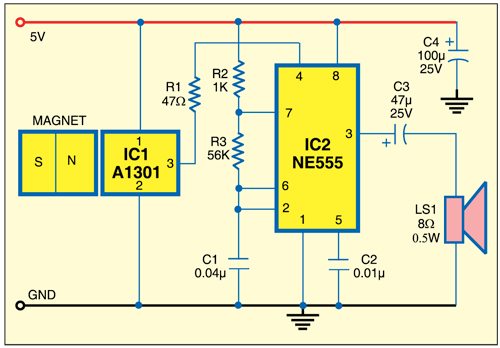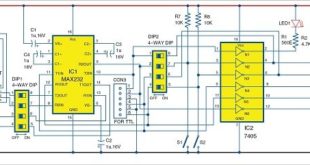This door open alarm uses an input sensor fixed at the corner of the door frame and a magnet fixed on the door panel close to the sensor. When the door is opened, the magnet moves away from the sensor, generating a controlling signal to sound the alarm.
The circuit is built around Hall sensor A1301 (IC1), timer NE555 (IC2), a powerful magnet and a few discrete components. The sensor is a three-terminal device. The voltage generated by it depends on the polarity of the magnet. The presence of south-polarity magnetic field, perpendicular to the branded face of the sensor, increases the output voltage of the sensor. Conversely, the presence of north-polarity magnetic field in the same orientation as the branded face of the sensor device decreases the sensor output.

NE555 is wired as an astable multivibrator whose reset pin 4 is controlled by the sensor output.
When the door is closed, the magnet is close to the sensor. Presence of north-polarity magnetic field generates a low voltage at the output of the sensor. As a result, pin 4 of NE555 also goes low and the timer does not oscillate. This de-activates the speaker indicating that the door is closed.
When the door is opened, the magnet moves away from the sensor. The output of the sensor goes high and pin 4 of IC2 also goes high. The timer oscillates and the speaker sounds to indicate that the door is open. The speaker sounds until the door is closed.
Assemble the circuit on a general-purpose PCB and enclose in a suitable case. Fix the Hall sensor at the corner of door frame and the magnet on the door, keeping its north pole (N) oriented towards the sensor. Align the sensor and magnet such that when the door is closed the output of the Hall sensor is low.
The circuit works off regulated 5V DC. An IC 7805-regulated supply can be used for the purpose.
The project was first published in Dec 2011 and has recently been updated.
This content was originally published here.








